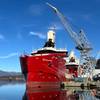By Ed Voigt, U.S. Army Corps of
Engineers, Philadelphia District
The U.S. Army Corps of Engineers oldest dredge is now also one of its youngest. The dustpan dredge Potter, the Corps last and longest-serving steam-powered dredge, helped keep the Mississippi River open to navigation for almost 70 years. Now she is back home at the St. Louis District Service Base after a $20 million repowering project by the district and the Corps' Marine Design Center (MDC). Halter Marine, Inc., of Gulfport, Miss, was the contractor. She departed Halter's New Orleans shipyard Sept. 29 with the same overall profile (minus smokestacks) and capabilities, but with an all-new stern and a diesel-electric power plant.
Named for Brig. Gen. Charles Lewis Potter, Memphis District Engineer from 1900 to 1903, and President of the Mississippi River Commission from 1920 to 1928, the Potter, originally a steam-powered paddlewheeler, was built for $520,000 and launched in 1932. She is the oldest member of the Corps' dredging fleet, a year older than the Jadwin, which was launched in 1933 and repowered in 1985.
The old steamer maintains the nine-foot-deep Upper Mississippi River Federal Navigation Channel between river miles 0 and 300. Dustpan dredging is the mode of choice along most of "Old Man River," where sand and fine-grained soils from the Missouri River dominate the channel. Of the Corps' Mississippi fleet, only the Thompson in St. Paul District is a cutterhead dredge, better suited to the rocky Upper Mississippi.
The Potter is authorized to dredge year-round, with its schedule driven by shoaling and constrained by river stages and seasonal "windows." The Corps' river dredging fleet handles about half of the annual federal channel maintenance along the Mississippi, with contract dredgers accounting for the rest.
The crew is organized into three shifts, with two alternating and one off at any given time. The Potter's master, pilot, and first mate each lead a shift, so there is always one officer on board with a master's license.
Nor has the ship's dredging equipment changed, except to replace old components. The new equipment is more efficient and state-of-the-art, but the operation remains the same. The Potter's dustpan cuts a 32-foot-wide swath along the river bottom. It is raised and lowered by a hoisting winch, and pulled forward by a pair of hauling winches.
The dredge pump (a new high-density model that nearly doubles the old capacity) sucks bottom sediment in through the intake pipe, facilitated by the jetting pump, which shoots water through 20 nozzles lining the bottom of the dustpan to stir up the sediment.
Most of the dredge's dimensions are also intact -- length 240 feet, six inches; beam 46 feet; draft seven feet, six inches; displacement 1,600 light tons.
As for the rest, the Potter's first engineer, Dennis Austin, said "Everything on the inside (at least everything that makes this dredge run) is new."
That is certainly true of the stern, which was completely replaced below the upper decks. The MDC set the functional requirements, then Halter determined the most cost-effective way to satisfy them.
"To accomplish all the needed modifications, the contractor had to remove large sections of the stern," said Alan Epps, who managed the repowering project for MDC. "But we gave them the choice of either replacing the entire stern or rebuilding the existing structure."
The most visible changes inside involve the boiler room, or rather the space it once occupied. In its place are three Caterpillar 3516B 1,825-kilowatt diesel generators (two for operation and one for standby) that feed a 600-volt main bus.
"Three was the ideal number for redundancy, allowing two in operation and one in reserve," said Epps. "Looking at the space, the Caterpillar 3516B offered the most efficient configuration."
The bus distributes power to four 1,200-horsepower GE Electric motors (two for propulsion and two to drive the dredge pump), a smaller motor for the jetting pump, and a Reliance 365-kilowatt motor generator set.
Controlling the propulsion and pump motors are state-of-the art digital silicon control rectifiers that convert the 600 volts of AC power from the generators to 750 volts DC. As a result, total horsepower is now up to 2,400 for both propulsion and dredging, compared to 1,800 and 1,400, respectively, before repowering.
The Reliance motor generator set supplies house power, lighting, heating and cooling, compressed air, and other utilities through a 480-volt bus.
"Installing a separate motor generator set was a choice we made based on experience from the Jadwin," said Epps. "After its conversion from steam to diesel-electric, there were a lot of computer and electronics problems related to interference from the main generators. This eliminates that problem by giving us 'clean' house power."
The design also compensated for the loss of the boilers. Said Austin, "We had to load 158 tons of steel-shot ballast below the deck just to make up for the loss of those boilers, so the dredge would sit at the same level in the water."
While most of changes were from the main deck down, the contract included some enhancements to the living areas, such as new flooring all through the galley. It also included a new water purification system that uses heat from the engines to distill river water into drinking water.
Another quality of life improvement was an internal stairway from the main to the upper deck. (All stairways were previously outside). The St. Louis District Engineer made the request to ensure the crew no longer had to weather the elements to move about in the ship.
Beyond physical changes, the Potter's conversion from steam to diesel-electric brought changes in both fleet and crew size. The dredging operation used to need six other vessels -- the tenders (workboats) Kimmswick and Prairie Du Rocher, two fuel barges, an anchor-handling derrick barge, and a storage barge for supplies and parts.
The conversion eliminated one fuel barge.
"Fuel oil consumption was so high with the steam plant that we had to refuel almost daily, so we needed two barges, one to refuel the dredge and another to refuel itself," said First Mate Terry Bequette. "But with diesel, she can go more than a week without refueling, so one barge is enough." The less frequent refuelings also means fewer man-hours.
The crew reduced from 59 to 50 due to eliminating the boiler room with its switches, valves, and other manual controls to operate and maintain. Retirements and transfers accounted for all nine positions, so no one had to be let go.
For the crew that remained, two weeks of field trials in October along a 300-foot-wide stretch of channel south of St. Louis introduced them to a much different Potter.
First impressions? For starters, the dredge is more fun to drive. "Driving it then versus now is like going from a Model T to a 2002 Cadillac," said Bequette. "It's like a dream."
"We have a third more horsepower, but it feels like even more," said Austin. "The new power plant is a lot more efficient and easy to handle."
Dredge equipment operator Carl Raines cites the elimination of the "bell stand," a bell on a stand used to communicate between the bridge and the engine room. Said Raines, "Whenever I needed to move the dredge, I had to first let the engine room know. Now it's all computerized and I control everything from here on the bridge."
"Cleaner, too," said Austin. "I notice I don't wear as much grease as I used to! That boiler room required a lot of maintenance, and most of it was pretty messy."
And there are always the intangibles. "What do I miss," asked Bequette. "The romance of steam, the memories of an era that's gone. What do I not miss? The smell, for one!"
So with somewhat less character, but a lot more capability, the Potter and her crew are back in business, carrying out their historic (and future) mission.
The preceding was reprinted, with permission, from January 2002 edition of the USACE's Engineer Update (Vol. 26, No. 1).
Sponsored Content
MSC Sets a New Standard for Time Off in 2025, Plus Earn a $38,340 Bonus as an Able Seaman!

Navigate Compliance with Confidence: Discover Carbon Diligence from ABS Wavesight

Featured videos

Xenos Marine Takes Aim at the Gulf Salvage, Decommissioning Markets

AI to the Rescue: Zelim’s ZOE to be Installed on Cruise Ship
April 2025
 Read the Magazine
Read the Magazine

 Read the Magazine
Read the Magazine
This issue sponsored by:

From Oil to Wind: Cross-Skill Pilot Exemplifies Just-Transition in Action
Subscribe for
Maritime Reporter E-News
Maritime Reporter E-News is the maritime industry's largest circulation and most authoritative ENews Service, delivered to your Email five times per week









